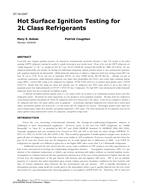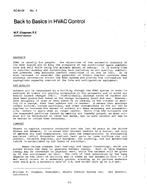The objective of ASHRAE Research Project 1092-RP was to develop a simplified model calibration procedure to allow building professionals to project annual cooling and heating energy consumption of buildings with multiple HVAC systems from short-term field measurement data.
The model calibration literature was reviewed and the scientific foundations of a simplified model calibration procedure were documented. The model calibration procedure compares “calibration signatures†with “characteristic signatures†in order to identify input variables that require change to achieve calibration. Calibration signatures are defined as temperature dependent plots of the differences (residuals) between the simulated and measured heating and cooling consumption measures. Characteristic signatures, on the other hand, are temperature- dependent plots of the change in simulated heating and cooling consumption caused by change of individual input parameters.
A step-by-step procedure for simplified model calibration was developed and validated in five case studies with an existing simulation program developed using the ASHRAE simplified energy analysis procedures (modified bin method and ASHRAE tool kits). Three case study buildings are in Omaha, Nebraska (cold weather) and two are in Texas (hot and humid weather). These buildings include single-duct, dual-duct, VAV and CAV systems. The two-level calibration procedure was shown to be a good approach for model calibration.
Five major conclusions were reached in this research project:
- The simplified model calibration procedure developed in the project can be used to accurately calculate long-term energy consumption using short-term field energy measurement data for different types of buildings with different systems.
- Calibration must be performed in order to accurately determine the system performance, even if detailed field information is collected.
- The short-term, hourly chilled water consumption and heating water consumption are the most critical energy data for model calibration. Hourly electric consumption has a limited effect on the accuracy of model calibration.
- The general information of the building and systems are the most critical input parameters for the simplified model calibration.
- The 1st level calibration procedure is very important and can improve the model accuracy significantly.
The advantages of this simplified model calibration procedure include the fact that the characteristic signatures and calibration signatures have real physical meaning. The procedure is less labor intensive, more cost effective, and more efficient than typical calibration procedures. In addition, the accuracy of the model is significantly improved, compared with the initial simulation, especially when detailed HVAC systems information is not available. Computer simulation guidelines can be developed based on the results of this research project.
Product Details
- Published:
- 2006
- Number of Pages:
- 225
- File Size:
- 1 file , 9.9 MB
- Product Code(s):
- D-28663


